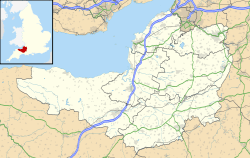Church of St John the Baptist, Ashbrittle facts for kids
Quick facts for kids Church of St John the Baptist, Ashbrittle |
|
|---|---|

Ashbrittle church and ancient yew tree
|
|
| 50°59′02″N 3°21′07″W / 50.9838°N 3.3519°W | |
| Location | Ashbrittle, Somerset |
| Country | England |
| Denomination | Church of England |
| Churchmanship | Conservative Evangelical |
| History | |
| Status | Active |
| Architecture | |
| Functional status | Parish church |
| Heritage designation | Grade II* listed |
| Designated | 25 January 1956 |
| Completed | 14th century |
The Church of St John the Baptist is an old and beautiful church in a village called Ashbrittle in Somerset, England. It's a Church of England parish church, which means it serves the local community. This special building was built a very long time ago, in the 15th century. It is also a Grade II* listed building, which means it's an important historical building that needs to be protected.
Contents
History of the Church
Building and Changes Over Time
The Church of St John the Baptist was built in the 1400s. Many years later, around 1874, the church had a big makeover. This was called a Victorian restoration. During this time, a clock was added to the church. Also, a natural spring was found flowing underneath the building.
The Church Today
Today, the church is part of the Wellington and District group of churches. This group belongs to the Diocese of Bath and Wells, which is a larger area of churches in the Church of England. The church follows a traditional style of worship within the Church of England.
Church Design and Features
What the Church Looks Like
The church building is made from red sandstone, with special hamstone details. It has a main area called the nave, a chancel (the part near the altar), and a tall, three-part tower at the west end. One of the beautiful stained glass windows in the church was given by Edward Watkin to remember his grandmother.
The Ancient Yew Tree
In the churchyard, there is a truly amazing Yew tree. This tree is incredibly old, possibly between 3,000 and 4,000 years old! In 2002, this Yew tree was chosen as one of the "Great British Trees." This list highlighted 50 special trees across Great Britain to celebrate the Queen's Golden Jubilee.
The tree grows on top of an ancient Bronze Age Bowl barrow, which is a type of burial mound from a very long time ago. The Yew tree is no longer one single trunk. It has divided into seven separate trunks that form a circle. This circle is about 42 feet (13 m) wide!


